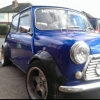Turbo's generally, but especially on old engines like the A, make their power by filling the cylinders when a normally aspirated engine would start to struggle in the reduced time available, each stroke, as the revs increase.
For the normally aspirated engine, the lowering of the pressure in the combustion chamber, just before the ignition fires, means combustion happens more slowly: hence the need for even more advance to get the most oomph applied to the piston once it passes top dead centre and can push the the same direction as the crank is rotating.
Since forced induction can keep the cylinders fuller, the burn rate stays more constant and the advance is more just to compensate for the faster rotating crank getting the piston past TDC sooner. Too much advance can mean the piston gets forced against the rotation of the crank, which allows the pressure to get much higher, before it's relieved by the piston sweeping down the bore, high pressure translates to high temperature and melted pistons.
Boost pressure and engine speed having opposite and independent effects on the ignition timing requirements is why it makes a lot of sense to fit programmable ignition, that can measure and compensate for both independently, to turbo engines.
















